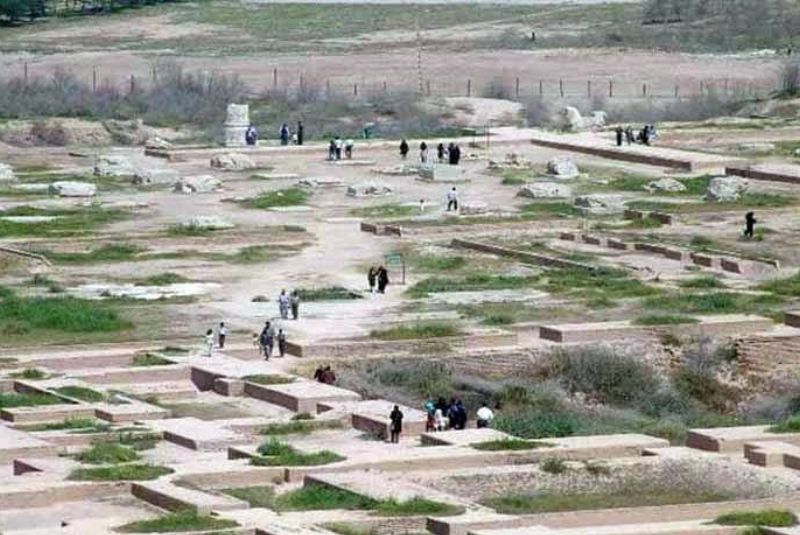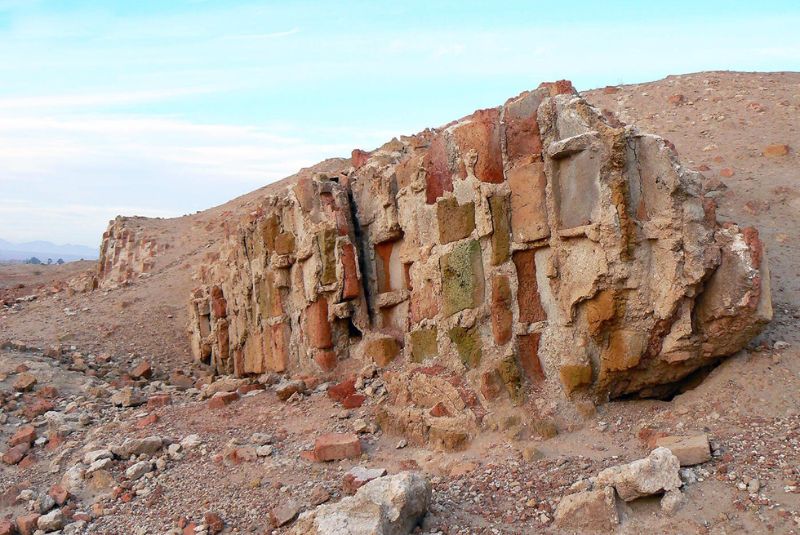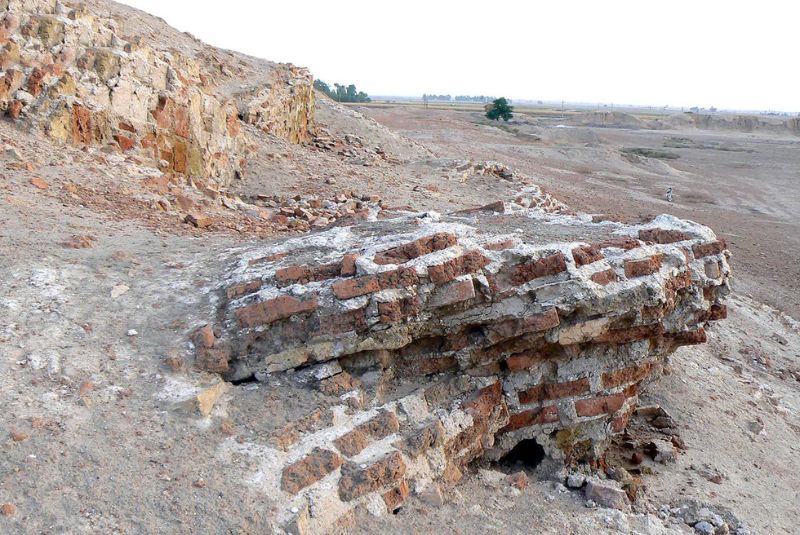Ivan Karkheh | The Largest Buried City of the Sassanid Empire
The sands of time hold buried the grandeur of Ivan Karkheh, an ancient city of the Sasanian period. Once a grand city, it is believed to be even larger than the nearby ancient city of Susa.
Much of Ivan Karkheh remains buried, shrouded in mystery, which is precisely what attracts tourists and archaeologists alike.
Join us as we delve into the fascinating history and captivating architecture of this remarkable city.
About Ivan Karkheh
Located 20 kilometers northwest of Susa, along the route to Dehloran, the ancient site of Iwan-e Karkheh holds the remains of a city from the Sassanid period, particularly during the reign of Shahpur II.
In 1930, Ivan Karkheh was registered in Iran National Heritage list. Despite restoration efforts in 1950, before the Islamic revolution, parts of the city's eastern wall were preserved. An asphalt road, constructed through the middle of the city, connected villages in the western Karkheh region.
Archaeologist Daniel T. Potts has identified various urban facilities within Ivan Karkheh, including pottery kilns and weaving workshops. The city was known for its silk weaving industry.
While restoration work has been undertaken, Ivan Karkheh faces challenges due to modern infrastructure encroachment, exemplified by the asphalt road that cut through its ancient walls.
Tumultuous History of Ivan Karkhe

Iwan-e Karkheh 's story is one intertwined with its predecessor, Susa. Historical sources depict Susa as a thriving metropolis during the early Sassanid era. However, a Christian rebellion ignited chaos and destruction within the city walls.
Following the suppression of the rebellion, which partially damaged Susa, King Shapur II made a pivotal decision. He ordered the construction of a new city, Ivan Karkhe, just a mile north of Susa, on the west bank of the Karkheh River. This marked the continuation of Susa's thousand-year legacy in a new form.
While Ivan Karkhe inherited Susa's legacy, it could never fully recapture its past glory. However, its historical and architectural significance remain undeniable.
| Suggestion: Firuzabad - The Rise and Fall of Gor City
Born from Religious Conflict:
Ivan Karkhe's origins were rooted in religious tension. Susa, under Shapur II, had witnessed a rise in Christianity. This development sparked friction with the Roman Empire, undergoing its own Christianization under Constantine the Great.
The Sassanid government, concerned about the growing Christian influence within its borders, viewed them with suspicion, especially of collaborating with Rome. This culminated in a rebellion by Susa's Christians against Shapur II. The king's response was swift and brutal. Historians tell of 400 war elephants razing Susa to the ground.
A New Capital with a Short Life:
Determined to prevent Susa's resurgence, Shapur II built Iwan-e Karkheh, also known as Iranshahr Shapur, as a replacement capital. Archaeological findings reveal that the chosen location had been inhabited throughout history, from the Paleolithic era to the modern settlement of Shushan.
A Flourishing City and a Fading Memory:
Information on Ivan Karkhe during the early Islamic centuries remains scarce. Some sources portray it as a prosperous city, boasting numerous forts, gardens, and bustling markets. Others recognize it as one of Khuzestan's most prominent cities, renowned across the world.
However, by the 8th century of the Islamic calendar, references to Ivan-e-Karkheh dwindle, and it disappears entirely from later historical records.
A Legacy of Change and Uncertainty
Iwan-e Karkheh 's story is one of rise from the ashes of conflict, only to fade into obscurity itself. While its prominence as a major city may have been short-lived, it serves as a testament to the dynamic nature of civilizations and the lasting impact of political and religious forces on urban development.
| Read more: Naqsh-e Rustam - Persian Empires' Treasures & Zoroastrian Legacy
The Mysterious Architecture of Ivan Karkheh

Ivan Karkhe's architecture paints a picture of a meticulously planned Sassanid city, yet one with intriguing contradictions.
Imagine a massive rectangular city stretching along the Karkheh River. Its perimeter was guarded by a formidable four-kilometer-long, one-kilometer-wide adobe wall. While the current state of the walls makes it difficult to pinpoint the exact number, historical accounts suggest there were four gates, each positioned along the cardinal directions.
However, only one grand entrance truly served as the official gateway. This southern gate boasted a lengthy and impressive baked-brick arch, considered one of the tallest porches of the Sassanid era.
The city's interior was divided into three distinct zones – north, central, and south – by two east-west walls. This layout might lead one to believe in a social hierarchy, with the central area reserved for the ruling class.
However, archaeological evidence throws a curveball. The central zone revealed scattered, weak structures, even an industrial pottery kiln. This contradicts the notion of an elite residential area.
| Also read about: Taq Bostan - Sassanid Rock Reliefs in Kermanshah, Iran

The southern sector, on the other hand, unveils a different story. Here, archaeologists discovered massive structures hinting at ceremonial purposes. Scattered cylindrical stone columns, possibly remnants of a Sassanid palace, further support this theory.
The year 1950 marked a turning point. Excavations unearthed two significant structures in the south. One, a grand palace constructed with brick and mortar, featured a central, domed hall with an adjoining 18-meter-long corridor. Arches spanned the corridor, providing support for the transverse cradle vault.
Another palace, boasting three porches and a central courtyard measuring a staggering 1200 meters wide, also came to light. Traces of paint on its walls suggest elaborate decorations. Both palaces, based on their size and ornamentation, likely served governmental and ceremonial functions.
Today, however, only a portion of this second palace remains, showcasing a central square vestibule flanked by rectangular ones to the north and south.
Ivan-e-Karkheh's architecture presents a captivating puzzle. While the city's layout suggests a potential class system, the archaeological finds paint a different picture.
The central zone's industrial activity and weak structures contradict the idea of an elite residence. Conversely, the south reveals monumental structures indicative of a ceremonial and governmental center.
| Suggestion: Bisotun (Behistun) - Rock Relief and Inscription of the Achaemenids
Final Takeaway
When planning your next adventure in Iran, be sure to include a visit to the ancient site of Ivan Karkheh on your itinerary.
For an unforgettable experience, head northwest from Susa to visit this ancient site. Proper footwear and clothing are essential for navigating the uneven terrain. Remember, the site experiences a tropical climate, so plan your visit for the cooler months for maximum comfort.
Share your story!
Comment below and let us know about your Experience.
Your story inspires others!


Comment
Leave a Comment